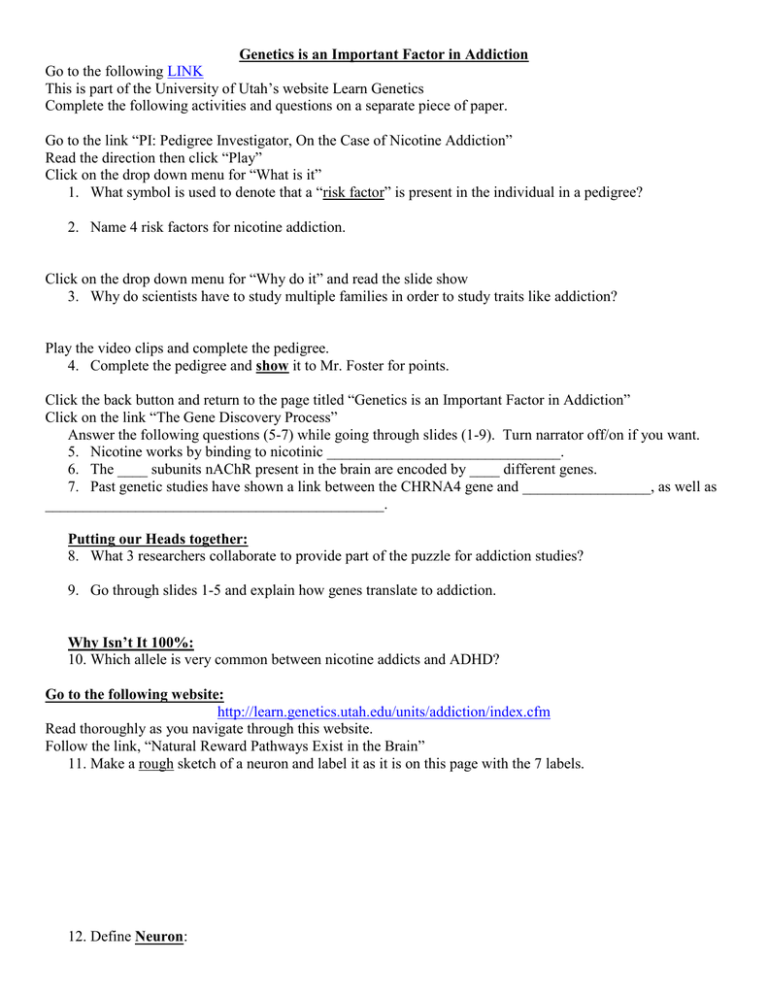Genetics is an Important Factor in Addiction
advertisement

Genetics is an Important Factor in Addiction Go to the following LINK This is part of the University of Utah’s website Learn Genetics Complete the following activities and questions on a separate piece of paper. Go to the link “PI: Pedigree Investigator, On the Case of Nicotine Addiction” Read the direction then click “Play” Click on the drop down menu for “What is it” 1. What symbol is used to denote that a “risk factor” is present in the individual in a pedigree? 2. Name 4 risk factors for nicotine addiction. Click on the drop down menu for “Why do it” and read the slide show 3. Why do scientists have to study multiple families in order to study traits like addiction? Play the video clips and complete the pedigree. 4. Complete the pedigree and show it to Mr. Foster for points. Click the back button and return to the page titled “Genetics is an Important Factor in Addiction” Click on the link “The Gene Discovery Process” Answer the following questions (5-7) while going through slides (1-9). Turn narrator off/on if you want. 5. Nicotine works by binding to nicotinic _______________________________. 6. The ____ subunits nAChR present in the brain are encoded by ____ different genes. 7. Past genetic studies have shown a link between the CHRNA4 gene and _________________, as well as _____________________________________________. Putting our Heads together: 8. What 3 researchers collaborate to provide part of the puzzle for addiction studies? 9. Go through slides 1-5 and explain how genes translate to addiction. Why Isn’t It 100%: 10. Which allele is very common between nicotine addicts and ADHD? Go to the following website: http://learn.genetics.utah.edu/units/addiction/index.cfm Read thoroughly as you navigate through this website. Follow the link, “Natural Reward Pathways Exist in the Brain” 11. Make a rough sketch of a neuron and label it as it is on this page with the 7 labels. 12. Define Neuron: Click through the slide show about how “The Reward Pathways Reinforce Behavior”. 13. What is the central job of the reward pathway? 14. The release of what chemical in the brain gives you a “little jolt of pleasure”? 15. The reward pathway connects two regions of the brain that are responsible for______and__________. Neurons communicate via the synapse 16. Define synapse: Click the “Back” button and return to the page titled “The New Science of Addiction: Genetics and the Brain”. Follow the link, “Drugs alter the Brain’s Reward Pathway”. 17. Which part of the brain do drugs cause dramatic changes in? 18. Explain why drug users develop a “tolerance” 19. The faster a drug is delivered to the system the ___________________________________________. Look at the PET scan of a brain belonging to a previous cocaine user. 20. Do the affects on the brain from cocaine go away very quickly? Click the “Back” button and return to the page titled “The New Science of Addiction: Genetics and the Brain”. Follow the link, “Genetics is an Important Factor in Addiction” 21. What are scientists looking for when they look for “addiction genes”? 22. Explain the difference between vulnerable and inevitable. (According to Dr. Hanson-Listen) 23. Explain what part of addiction is probably determined by genetics. (Listen to Dr. Hanson) 24. The ___________allele in the dopamine receptor gene __________________ is more common in people addicted to cocaine or alcohol. 25. Non-smokers are more likely than smokers to carry a protective gene, __________, which causes them to feel more nausea and dizziness from smoking. 26. Alcoholism is rare in people with two copies of the _____________ gene variation. Click on “Learn more about using mice to study addiction”. 27. How does selectively breeding mice teach us about genetics of addiction? 28. Name 4 other animals that can be used to study genetics of addiction. Click the “Back” button and return to the page titled “Genetics is an important factor in addiction”. 29. How can drugs be used to help addicts?








